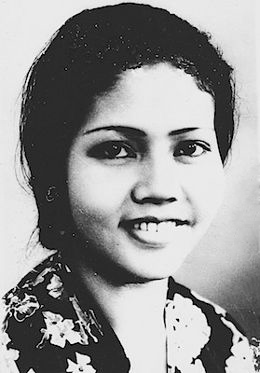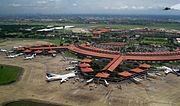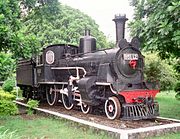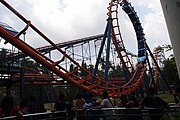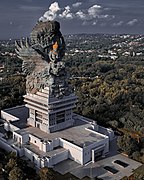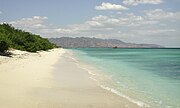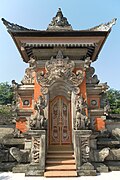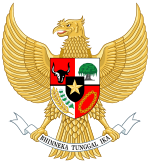Portal:Indonesia


Indonesia, officially the Republic of Indonesia, is a country in Southeast Asia and Oceania between the Indian and Pacific oceans. It consists of over 17,000 islands, including Sumatra, Java, Sulawesi, and parts of Borneo and New Guinea. Indonesia is the world's largest archipelagic state and the 14th-largest country by area, at 1,904,569 square kilometres (735,358 square miles). With over 279 million people, Indonesia is the world's fourth-most-populous country and the most populous Muslim-majority country. Java, the world's most populous island, is home to more than half of the country's population.
Indonesia is a presidential republic with an elected legislature. It has 38 provinces, of which nine have special autonomous status. The country's capital, Jakarta, is the world's second-most-populous urban area. Indonesia shares land borders with Papua New Guinea, East Timor, and the eastern part of Malaysia, as well as maritime borders with Singapore, Vietnam, Thailand, the Philippines, Australia, Palau, and India. Despite its large population and densely populated regions, Indonesia has vast areas of wilderness that support one of the world's highest levels of biodiversity.
Indonesia consists of thousands of distinct native ethnic and hundreds of linguistic groups, with Javanese being the largest. A shared identity has developed with the motto "Bhinneka Tunggal Ika" ("Unity in Diversity" literally, "many, yet one"), defined by a national language, cultural diversity, religious pluralism within a Muslim-majority population, and a history of colonialism and rebellion against it. The economy of Indonesia is the world's 16th-largest by nominal GDP and the 7th-largest by PPP. It is the world's third-largest democracy, a regional power, and is considered a middle power in global affairs. The country is a member of several multilateral organisations, including the United Nations, World Trade Organization, G20, and a founding member of the Non-Aligned Movement, Association of Southeast Asian Nations, East Asia Summit, D-8, APEC, and the Organisation of Islamic Cooperation. (Full article...)
The 1740 Batavia massacre (Dutch: Chinezenmoord, lit. 'Murder of the Chinese'; Indonesian: Geger Pacinan, lit. 'Chinatown tumult') was a massacre and pogrom in which European soldiers of the Dutch East India Company killed ethnic Chinese residents of the port city of Batavia, Dutch East Indies, (present-day Jakarta) in the Dutch East Indies. The violence in the city lasted from 9 October 1740, until 22 October, with minor skirmishes outside the walls continuing late into November that year. Historians have estimated that at least 10,000 ethnic Chinese were massacred; just 600 to 3,000 are believed to have survived.
In September 1740, as unrest rose among the Chinese population, spurred by government repression and declining sugar prices, Governor-General Adriaan Valckenier declared that any uprising would be met with deadly force. On 7 October, hundreds of ethnic Chinese, many of them sugar mill workers, killed 50 Dutch soldiers, leading Dutch troops to confiscate all weapons from the Chinese populace and to place the Chinese under a curfew. Two days later, rumors of Chinese atrocities led other Batavian ethnic groups to burn Chinese houses along Besar River and Dutch soldiers to fire cannons at Chinese homes in revenge. The violence soon spread throughout Batavia, killing more Chinese. Although Valckenier declared an amnesty on 11 October, gangs of irregulars continued to hunt down and kill Chinese until 22 October, when the governor-general called more forcefully for a cessation of hostilities. Outside the city walls, clashes continued between Dutch troops and rioting sugar mill workers. After several weeks of minor skirmishes, Dutch-led troops assaulted Chinese strongholds in sugar mills throughout the area. (Full article...)
Photographer: SMasters; License: Creative Commons CC-BY-SA
Religions in Indonesia
Southeast Asia
Other countries
Roekiah (Perfected Spelling: Rukiah; 31 December 1917 – 2 September 1945), often credited as Miss Roekiah, was an Indonesian kroncong singer and actress. The daughter of two stage performers, she began her career at the age of seven; by 1932 she had become well known in Batavia, Dutch East Indies (now Jakarta, Indonesia), as a singer and stage actress. Around this time she met Kartolo, whom she married in 1934. The two acted in the 1937 hit film Terang Boelan, in which Roekiah and Rd Mochtar played young lovers.
After the film's commercial success, Roekiah, Kartolo, and most of the cast and crew of Terang Boelan were signed to Tan's Film, first appearing for the company in their 1938 production Fatima. They acted together in two more films before Mochtar left the company in 1940; through these films, Roekiah and Mochtar became the colony's first on-screen couple. Mochtar's replacement, Rd Djoemala, acted with Roekiah in four films, although these were less successful. After the Japanese invaded the Indies in 1942, Roekiah took only one more film role before her death; most of her time was used entertaining Japanese forces. (Full article...)- ... that customarily, in a Minangkabau marriage (pictured), the bridegroom lives with his sister and visits his wife's house only at night?
- ... that Ayu Utami's 1998 novel Saman launched an Indonesian literary movement focusing on women's views of sexuality?
- ... that environmentalists fear that the mine on Sebuku Island could sink it?

- ... that Andrei Angouw is the first Confucian mayor in Indonesia?
- ... that Indonesian politician Muhammad Rapsel Ali founded a motorcycle racing team?
- ... that Kamrussamad lost five Indonesian elections before finally winning a seat on the People's Representative Council in 2019?
- ... that although he was a former Indonesian prime minister, Soekiman Wirjosandjojo was not arrested during a political purge as he was considered a non-threat?
- ... that even though a village said that it did not want a church, Indonesian politician Thoriqul Haq allocated land and money to build one along with a musalla?
- ... that Ahmad Nasuhi ordered a subordinate to attack the Indonesian Communist Party's offices with grenades as "psychological warfare against the central government"?
- 1 June 1945 – President Sukarno first outlines his idea of Pancasila, now Indonesia's state philosophy
- 7 June 1999 – Indonesia's first free and fair national elections since 1955 take place, but no party gains a majority
- 10 June 2009 – The Suramadu Bridge (pictured), the longest in Indonesia, opens
- 17 June 1864 – The first railway track in Indonesia was laid between Semarang and Tanggung, Central Java
- 27 June 1970 – President Sukarno becomes the first Indonesian president to die; he is buried in Blitar, East Java
Rules | Match log | Results page (for watching) | Last updated: 2024-06-11 20:30 (UTC)
Note: The list display can now be customized by each user. See List display personalization for details.
- Du Croo & Brauns (edit | talk | history | links | watch | logs | tools) by Bob1960evens (talk · contribs · new pages (3)) started on 2024-06-11, score: 32
- Aji Raden Sayid Mohammad (edit | talk | history | links | watch | logs | tools) by Faldi00 (talk · contribs · new pages (18)) started on 2024-06-11, score: 129
- Bidadari Surgamu (edit | talk | history | links | watch | logs | tools) by DannyMalhotra (talk · contribs · new pages (2)) started on 2024-06-11, score: 43
- 2024–25 ASEAN Club Championship group stage (edit | talk | history | links | watch | logs | tools) by Fau Tzy (talk · contribs · new pages (6)) started on 2024-06-10, score: 29
- Mauresmo Hinoke (edit | talk | history | links | watch | logs | tools) by Conam-san (talk · contribs · new pages (3)) started on 2024-06-10, score: 46
- 2024 Asian Men's U20 Volleyball Championship (edit | talk | history | links | watch | logs | tools) by Alifahmad14 (talk · contribs · new pages (1)) started on 2024-06-09, score: 63
- Australian Eastern Mission (edit | talk | history | links | watch | logs | tools) by ITBF (talk · contribs · new pages (9)) started on 2024-06-09, score: 35
- Kuntilanak 2 (edit | talk | history | links | watch | logs | tools) by DareshMohan (talk · contribs · new pages (34)) started on 2024-06-08, score: 53
- Bahasa Tanah (edit | talk | history | links | watch | logs | tools) by Elijah Mahoebessy (talk · contribs · new pages (3)) started on 2024-06-06, score: 139
- 2023–24 Liga 3 (Indonesia) final (edit | talk | history | links | watch | logs | tools) by Fau Tzy (talk · contribs · new pages (6)) started on 2024-05-26, score: 163
- Wies van Groningen (edit | talk | history | links | watch | logs | tools) by MumphingSquirrel (talk · contribs · new pages (4)) started on 2024-06-08, score: 75
- 2024–25 Persija Jakarta season (edit | talk | history | links | watch | logs | tools) by Catalyszczowski (talk · contribs · new pages (1)) started on 2024-06-08, score: 160
- Niki discography (edit | talk | history | links | watch | logs | tools) by Nkon21 (talk · contribs · new pages (4)) started on 2024-06-08, score: 50
- Rich Brian discography (edit | talk | history | links | watch | logs | tools) by Nkon21 (talk · contribs · new pages (4)) started on 2024-06-08, score: 43
- Cultural impact of Dwiki Dharmawan (edit | talk | history | links | watch | logs | tools) by SarahJH07 (talk · contribs · new pages (1)) started on 2024-06-08, score: 42
- Bolaang (edit | talk | history | links | watch | logs | tools) by TentingZones1 (talk · contribs · new pages (3)) started on 2024-06-08, score: 22
- Rhotana (edit | talk | history | links | watch | logs | tools) by Bernhard Zelazny (talk · contribs · new pages (17)) started on 2024-06-07, score: 30
- Victor Jacob Koningsberger (edit | talk | history | links | watch | logs | tools) by Crisco 1492 (talk · contribs · new pages (21)) started on 2024-06-07, score: 32
- List of IBL Indonesia annual scoring leaders (edit | talk | history | links | watch | logs | tools) by Skyggestadium (talk · contribs · new pages (3)) started on 2024-06-07, score: 73
- Abdul Wahid (politician) (edit | talk | history | links | watch | logs | tools) by Faldi00 (talk · contribs · new pages (18)) started on 2024-06-07, score: 93
- João Ferrari (edit | talk | history | links | watch | logs | tools) by Heavenlyjump (talk · contribs · new pages (4)) started on 2024-06-07, score: 61
- Fernandinho (footballer, born September 1994) (edit | talk | history | links | watch | logs | tools) by Heavenlyjump (talk · contribs · new pages (4)) started on 2024-06-07, score: 79
- God Said No World Tour (edit | talk | history | links | watch | logs | tools) by Oscarozzi (talk · contribs · new pages (3)) started on 2024-06-06, score: 38
- 2018 Malang mayoral election (edit | talk | history | links | watch | logs | tools) by Juxlos (talk · contribs · new pages (33)) started on 2024-06-06, score: 73
- Land language (edit | talk | history | links | watch | logs | tools) by Elijah Mahoebessy (talk · contribs · new pages (3)) started on 2024-06-06, score: 139
- Riza Herdavid (edit | talk | history | links | watch | logs | tools) by Juxlos (talk · contribs · new pages (33)) started on 2024-06-06, score: 93
- Mukomuko language (edit | talk | history | links | watch | logs | tools) by Cal1407 (talk · contribs · new pages (3)) started on 2024-06-05, score: 123
- 2024 South Bangka regency election (edit | talk | history | links | watch | logs | tools) by Juxlos (talk · contribs · new pages (33)) started on 2024-06-05, score: 83
- Nova Liana (edit | talk | history | links | watch | logs | tools) by Wakekigrand (talk · contribs · new pages (2)) started on 2024-06-05, score: 62
- Orang Pulo language (edit | talk | history | links | watch | logs | tools) by Cal1407 (talk · contribs · new pages (3)) started on 2024-06-05, score: 143
- 2011–12 NBL Indonesia season (edit | talk | history | links | watch | logs | tools) by Skyggestadium (talk · contribs · new pages (3)) started on 2024-06-05, score: 83
- 2020 South Tangerang mayoral election (edit | talk | history | links | watch | logs | tools) by Juxlos (talk · contribs · new pages (33)) started on 2024-05-29, score: 63
- Pura Rambut Siwi (edit | talk | history | links | watch | logs | tools) by Pueblo89 (talk · contribs · new pages (4)) started on 2024-06-04, score: 83
- Rankings of Southeast Asia Startups (edit | talk | history | links | watch | logs | tools) by Applaused (talk · contribs · new pages (4)) started on 2024-06-04, score: 63
- National Socialist Movement in the Dutch East Indies (edit | talk | history | links | watch | logs | tools) by Sartricis (talk · contribs · new pages (2)) started on 2024-06-04, score: 30
- Melati Tedja (edit | talk | history | links | watch | logs | tools) by Aestvoyage (talk · contribs · new pages (1)) started on 2024-06-04, score: 151
- All-IBL Indonesian Team (edit | talk | history | links | watch | logs | tools) by Skyggestadium (talk · contribs · new pages (3)) started on 2024-06-04, score: 108
- Nusa Penida Balinese language (edit | talk | history | links | watch | logs | tools) by Cal1407 (talk · contribs · new pages (3)) started on 2024-06-03, score: 112
- Nommensen HKBP University (edit | talk | history | links | watch | logs | tools) by Kris Simbolon (talk · contribs · new pages (1)) started on 2024-06-03, score: 83
- 2024–25 Bali United F.C. season (edit | talk | history | links | watch | logs | tools) by Wira rhea (talk · contribs · new pages (1)) started on 2024-06-03, score: 30
- Mapi (edit | talk | history | links | watch | logs | tools) by Hameltion (talk · contribs · new pages (22)) started on 2024-06-02, score: 42
- Ombilinichthys (edit | talk | history | links | watch | logs | tools) by Zanahary (talk · contribs · new pages (5)) started on 2024-06-02, score: 63
- Tetum (edit | talk | history | links | watch | logs | tools) by PK2 (talk · contribs · new pages (29)) started on 2024-06-01, score: 22
- Tetum people (edit | talk | history | links | watch | logs | tools) by PK2 (talk · contribs · new pages (29)) started on 2024-06-01, score: 73
- Ethnic groups in Southeast Asia (edit | talk | history | links | watch | logs | tools) by Hemant Dabral (talk · contribs · new pages (81)) started on 2024-05-31, score: 64
- Edy Junaedi Harahap (edit | talk | history | links | watch | logs | tools) by EmeraldRange (talk · contribs · new pages (2)) started on 2024-05-31, score: 61
- Baruch (surname) (edit | talk | history | links | watch | logs | tools) by Altenmann (talk · contribs · new pages (150)) started on 2024-05-30, score: 22
- Utopia castelnaudi (edit | talk | history | links | watch | logs | tools) by Dyanega (talk · contribs · new pages (4)) started on 2024-05-30, score: 40
- 1898 Ambon earthquake (edit | talk | history | links | watch | logs | tools) by Inharmswayhelp (talk · contribs · new pages (1)) started on 2024-05-30, score: 73
- Ohorella (edit | talk | history | links | watch | logs | tools) by Faldi00 (talk · contribs · new pages (18)) started on 2024-05-30, score: 42
- Nahumarury (edit | talk | history | links | watch | logs | tools) by Faldi00 (talk · contribs · new pages (18)) started on 2024-05-30, score: 42
- Lestaluhu (edit | talk | history | links | watch | logs | tools) by Faldi00 (talk · contribs · new pages (18)) started on 2024-05-30, score: 42
- Non-structural institution (edit | talk | history | links | watch | logs | tools) by TheBrowniess (talk · contribs · new pages (13)) started on 2024-05-30, score: 32
- Duin en Kruidberg (edit | talk | history | links | watch | logs | tools) by Ipflo (talk · contribs · new pages (6)) started on 2024-05-29, score: 28
- Bina Bektiati (edit | talk | history | links | watch | logs | tools) by Dsp13 (talk · contribs · new pages (12)) started on 2024-05-29, score: 72
- Sonita Lontoh (edit | talk | history | links | watch | logs | tools) by BINK Robin (talk · contribs · new pages (2)) started on 2024-05-22, score: 40
- Batam metropolitan area (edit | talk | history | links | watch | logs | tools) by Applaused (talk · contribs · new pages (4)) started on 2024-05-29, score: 152
- Waqf Agency (edit | talk | history | links | watch | logs | tools) by TheBrowniess (talk · contribs · new pages (13)) started on 2024-05-29, score: 63
- 2024 Banyuwangi regency election (edit | talk | history | links | watch | logs | tools) by Juxlos (talk · contribs · new pages (33)) started on 2024-05-29, score: 63
- Carel Joseph van Kempen (edit | talk | history | links | watch | logs | tools) by Tiny Particle (talk · contribs · new pages (21)) started on 2024-05-29, score: 34
- Ade Sugianto (edit | talk | history | links | watch | logs | tools) by Juxlos (talk · contribs · new pages (33)) started on 2024-05-29, score: 63
- Ali Yusuf Siregar (edit | talk | history | links | watch | logs | tools) by Juxlos (talk · contribs · new pages (33)) started on 2024-05-29, score: 73
- Press Council (Indonesia) (edit | talk | history | links | watch | logs | tools) by TheBrowniess (talk · contribs · new pages (13)) started on 2024-05-29, score: 73
- Ashari Tambunan (edit | talk | history | links | watch | logs | tools) by Juxlos (talk · contribs · new pages (33)) started on 2024-05-29, score: 72
- Tatto Suwarto Pamuji (edit | talk | history | links | watch | logs | tools) by Juxlos (talk · contribs · new pages (33)) started on 2024-05-29, score: 73
- Makassar metropolitan area (edit | talk | history | links | watch | logs | tools) by Applaused (talk · contribs · new pages (4)) started on 2024-05-29, score: 153
- Idza Priyanti (edit | talk | history | links | watch | logs | tools) by Juxlos (talk · contribs · new pages (33)) started on 2024-05-29, score: 63
Want to help?:
The following Wikimedia Foundation sister projects provide more on this subject:
-
Commons
Free media repository -
Wikibooks
Free textbooks and manuals -
Wikidata
Free knowledge base -
Wikinews
Free-content news -
Wikiquote
Collection of quotations -
Wikisource
Free-content library -
Wikiversity
Free learning tools -
Wikivoyage
Free travel guide -
Wiktionary
Dictionary and thesaurus


